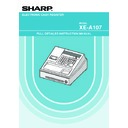Sharp XE-A107 (serv.man3) User Manual / Operation Manual ▷ View online
11
4
. Making.Basic.Sales.Entries.(Department.Entries)
In this section, the basic sales entry method using department key with simple correction (void)
method is explained. For more information such as PLU entries, VAT(tax) entries and entries using
function keys, please refer to “Utilizing Various Features for Sales Entries” section on page 13.
method is explained. For more information such as PLU entries, VAT(tax) entries and entries using
function keys, please refer to “Utilizing Various Features for Sales Entries” section on page 13.
Example
Selling a 15.00 item (dept. 1) and an 8.00 item (dept. 7) for cash and receiving
25.00 from your customer. (tax system: manual VAT1-4)
1.
Set the mode switch to the REG position.
2.
Enter the price for the department item (in case of 15.00).
3.
Press the appropriate department key. (in case of department 1)
4.
Enter the price for the department item (in case of 8.00).
5.
Press the appropriate department key. (in case of department 7)
For department 5 to department 8, press
H
before pressing the department key.
Repeat steps 4 and 5 for all the department items.
6.
Press
u
to display the amount due. (In case you do not print the tax amount in step 7, you can
omit this step.)
7.
Press
U
to print the tax amount in case your tax system is manual VAT1-4 system (default
setting). (You can omit this step.)
8.
Enter the amount received from the customer. (You can omit this step if the amount tendered is
the same as the subtotal.)
9.
Press
A
, and the change due is displayed and the drawer is opened.
10.
Tear off the receipt and give it to the customer (in case you programmed receipt printing) with
his or her change displayed.
11.
Close the drawer.
NOTE
• When paid by cheque, press
C
instead of
A
.
• When paid by credit, omit the step 8 and press
c
instead of
A
.
• If you preset unit prices to departments, you can omit entering the unit price of the
department item, that is, omit the step 2 and 4 shown above. For the programming, refer
to the “Department Preset Unit Price Programming” section on page 23.
to the “Department Preset Unit Price Programming” section on page 23.
• For details on the corrections, please refer to “Corrections” section on page 18.
Key.operation.example
.
Operator.display
.
Receipt.print
.
15:
!
8:
H#
u
U
25:
A
Date
Time
Consecutive No.
12
12
5
. Reading/Resetting.Sales.Data
In order to check sales, you can read a sales report. Also you should reset sales data after you
practicing your cash register.
To read a sales report, you should take an X report; set the mode switch to the X/Flash position, and
press
practicing your cash register.
To read a sales report, you should take an X report; set the mode switch to the X/Flash position, and
press
A
.
To reset sales, you should take a Z report; set the mode switch to the Z/PGM position, and press
C
. The sales data accumulated and the ground total (GT) is cleared.
If you print a Z report without grand total (GT) resetting, press
A
.
To.issue.an.X.report:
1.
Set the mode switch to the X/Flash position.
2.
Press
A
.
To.issue.a.Z.report.with.resetting.of.GT.(after.practicing):
1.
Set the mode switch to the Z/PGM position.
2.
Press
C
.
To.issue.a.Z.report.without.resetting.of.GT:
1.
Set the mode switch to the Z/PGM position.
2.
Press
A
.
For reading and resetting of actual sales data, please refer to “Reading and Resetting of Sales”
section on page 19. You should reset sales data at the end of each day to clear sales data.
section on page 19. You should reset sales data at the end of each day to clear sales data.
13
13
Utilizing.Various.Features.for.Sales.Entries
Before making sales entries, make sure that a paper roll is installed in case
receipt function is on. Also make sure to turn the mode switch to the REG
position.
PLU.Entries
Enter the PLU code of a PLU item and press
p
. The PLU item will be registered.
Example
Selling.a.PLU1.item.and.a.PLU15.item.by.credit.
Key.operation.example
.
Receipt.print
.
1p
15p
c
NOTE
To use PLU item sales entry, you must program PLUs. For the programming, refer to
the “PLU Programming” section on page 23.
14
14
Convenient.Sales.Entries
When.selling.only.item.by.cash.(Single Item Cash Sale (SICS) entry)
When a sale is for only one item paid by cash, such as a pack of cigarettes, you can use SICS
function. It is applicable only to department keys programmed for SICS or to PLUs associated with
such departments. The drawer opens after pressing the department or PLU key.
When.entering.more.than.one.of.the.same.department.or.PLU.items
When.entering.more.than.one.of.the.same.department.or.PLU.items
You can enter two or more of the same department or PLU item by pressing department or PLU key
repeatedly (
repetitive.entry), or by using the multiplication key (multiplication.entry). It will be
convenient to use the multiplication key when selling the same item in bulk. For operation, refer to
the example shown below.
Example
. Repetitive.entry
Selling two 2.00 items (dept. 1) and three PLU5 items for cash
Key.operation.example
.
Receipt.print
.
2:!
!
5p
p
p
p
A
Example
..Multiplication.entry
Selling six 1.50 items (dept. 1) and twelve PLU5 items for cheque payment
Key.operation.example
.
Receipt.print
.
6Q
150!
12Q
5p
u
C
Mixed.tender.sale
When the amount tendered by cash or cheque is less than the sales amount including tax, the
display shows a deficit and “ ”. To compensate for the deficit, make an additional amount-tendered
entry or make a credit entry.
Example
. Your customer pays 8.30 in cash and 50.00 by credit for an including-tax subtotal
of 58.30.
Key.operation.example
.
Receipt.print
.
50:!
830!
830!
u
Amount received in cash
830
Displays a deficit and “ ”
A
c
Click on the first or last page to see other XE-A107 (serv.man3) service manuals if exist.

